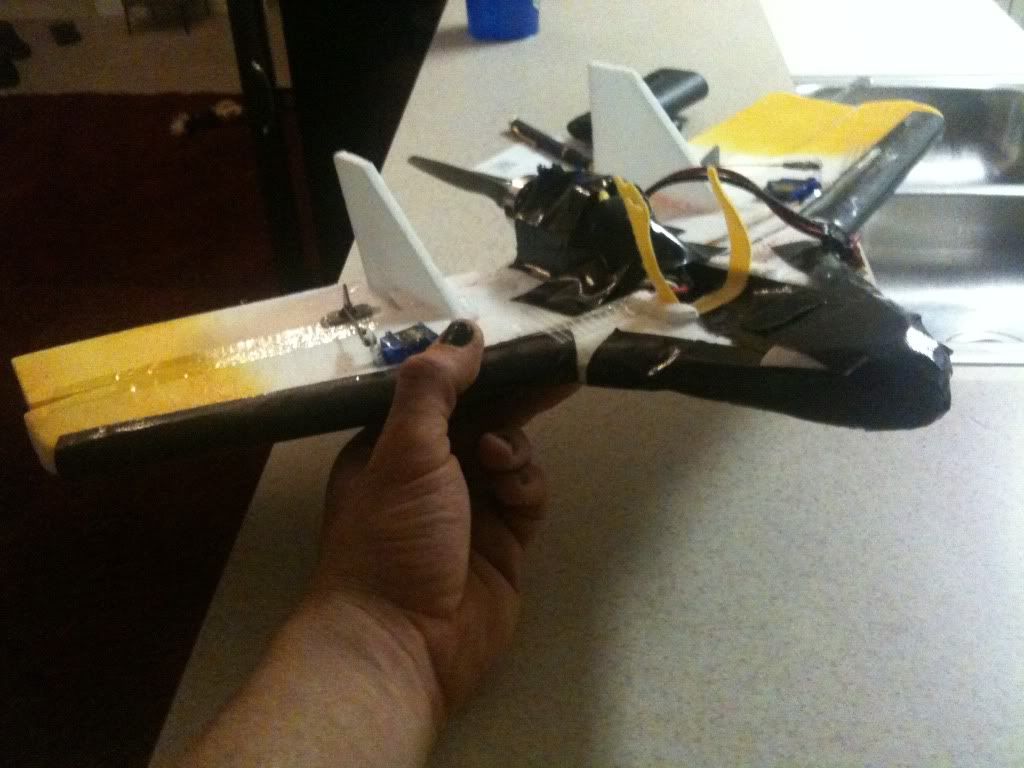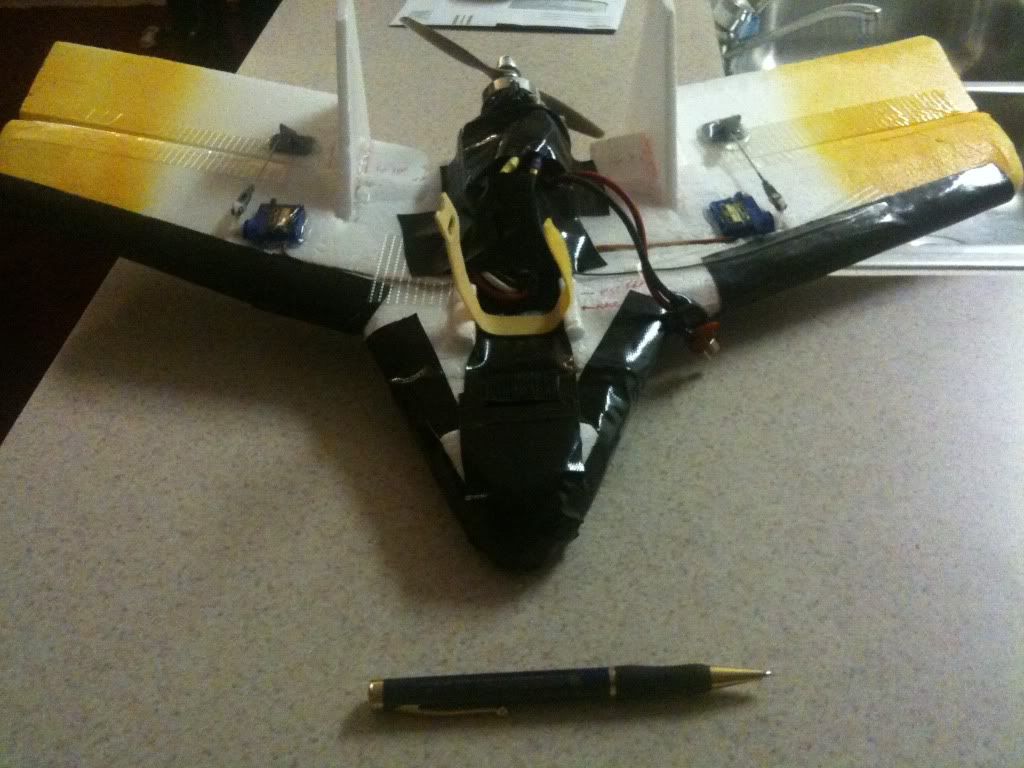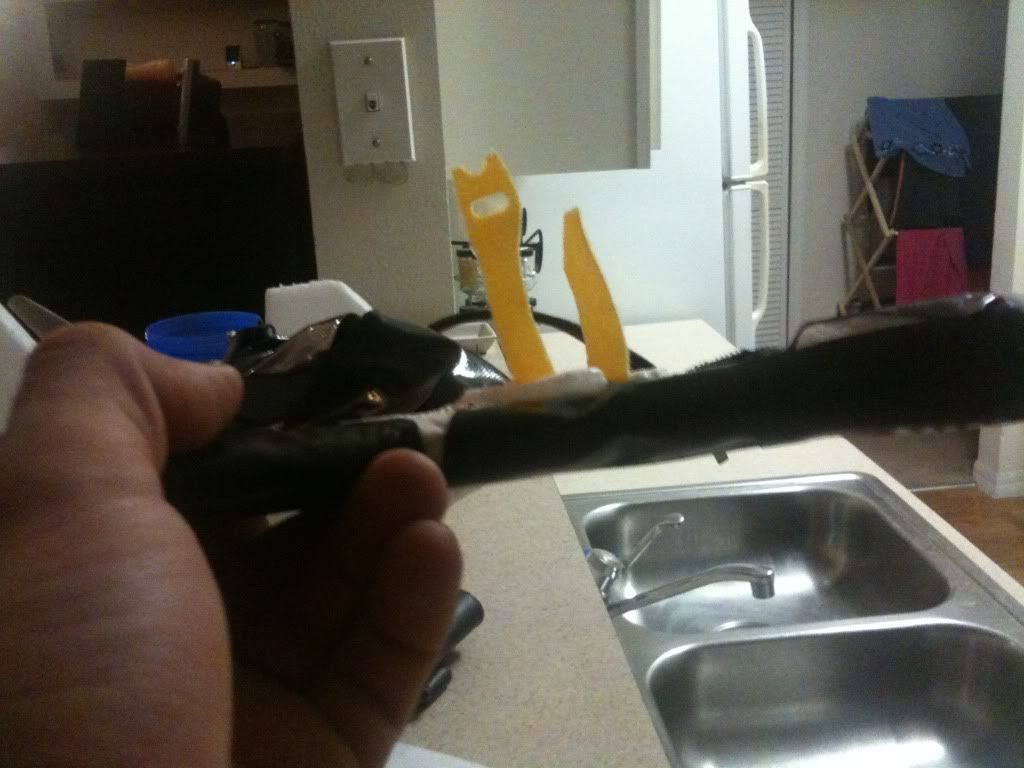|
|
Post by Gabe on Sept 26, 2010 11:08:56 GMT -6
Could you elaborate 19K?
On another note, I think I'm retiring this little guy. She flew GREAT today!! 224 watts on a 5.5x4.75 prop! Probably in excess of 60mph. Excellent hard banked turns, extreme roll rate and very responsive!
Then I cleaned her up and added some permanent foam instead of tape - COG was just a little heavier in the front now. She didn't like that on the landing. Lawn darted from 20' up after over correcting and she's toast.
Fun while it lasted!
|
|
19000rpm
Moderator    FIRST 30 MEMBER
FIRST 30 MEMBER
Posts: 5,183
|
Post by 19000rpm on Sept 26, 2010 17:03:48 GMT -6
You shouldn't ask me to elaborate.  As you know, the COG is a fixed point on the airframe where the plane balances based on the amount of weight, forward and aft, and the point where the maximum, or most effective, amount of lift is generated. This can be best observed by the glide angle a plane has. A relatively level glide angle means you've got the COG right. When flying very high speed planes it's easy to be fooled into thinking the COG is all right because it's flying more like a projectile than a plane until the power comes off. Surprise, surprise.  There is only one COG per airframe. Period. It doesn't move unless you change the lifting area size and/or central location. As a rule of thumb: In many modern swept wings, essentially modified delta designs, like the F22, 27 and 35, the COG is close to the point where a line drawn from the wing tips through the fuse meet. This isn't an absolute though, because the location of the lifting areas from design to design are not the same. For instance: On your strykers the wing extends forward and the entire length of the plane, including some of the fuse, as in "lifting body" airframes, have become integral lifting surfaces instead of just the wing and, to some extent, the horizontal stab. So using the rule of thumb is only a starting point. There in lies the challenge of finding it in any way other than the way you did. Trial and error.  |
|
|
|
Post by Gabe on Sept 26, 2010 18:35:27 GMT -6
Well, with that in mind, it's somewhere in that vicinity- and it's extremely sensitive with the movement of the battery. 1/2 in aft and it's toast, 1/2 in front and it's nose heavy. I can't leave well enough alone. I cut off the nose and grafted new foam with 5 toothpicks and some extreme and gorilla tape and hot glue:    Test flight tomorrow. She should be nose heavy with the extra foam. |
|
19000rpm
Moderator    FIRST 30 MEMBER
FIRST 30 MEMBER
Posts: 5,183
|
Post by 19000rpm on Sept 27, 2010 5:31:56 GMT -6
Good luck!
|
|
|
|
Post by Gabe on Sept 28, 2010 8:30:25 GMT -6
Ok guys, I need to pick your brains. Found the COG an she flies pretty good! BUT - she has a tendency to stall in a turn and the nose will dip. More speed and power obviously solves the issue in the air.
Also, the roll rate is way too high but I need a lot of elevator to keep her responsive. With a delta setup this is an issue. I have oversized elevons right now and I'm wondering if that is part of the problem. They literally stick out last the trailing edge of the wing.
Can anyone provide some input?
|
|
akent
Moderator    FIRST 30 MEMBER
I love the 500!
FIRST 30 MEMBER
I love the 500!
Posts: 2,826
|
Post by akent on Sept 28, 2010 9:32:29 GMT -6
That's great she's flying!
For in flight CG, you can get it going straight and trimmed, then let off the gas. If it nose dives, the CG is too far forward. If it balloons up or porpoises, it's too far back.
It should just gently nose down if the CG is good.
You should be able to turn down the roll rate without affecting the elevator function in the radio. I don't remember exactly how at the moment, but it is doable with the mixes.
|
|
|
|
Post by Gabe on Sept 28, 2010 9:53:01 GMT -6
Yup I got all that (thank you, by the way).
I was more curious to see if anyone knows why it stalls when I start a steep bank. The stock Stryker never did that. I'm assuming its something to do with the wing shape or wing area.
|
|
19000rpm
Moderator    FIRST 30 MEMBER
FIRST 30 MEMBER
Posts: 5,183
|
Post by 19000rpm on Sept 30, 2010 6:32:32 GMT -6
If it's not nose heavy: The wing loading is too high. In other words; it's too heavy for the wing area. When you bank steeply the lift isn't sufficient, so the nose drops off dramatically.
|
|
|
|
Post by Gabe on Sept 30, 2010 9:13:34 GMT -6
You're right. I posted over on rcuniverse and rcgrouos and they said the same thing. The kicker was when I finished my new stock Stryker today and noticed how light is was with the battery installed. The wind just wanted to pick it up out of my hand. I gotta re-think the power train on this little guy.
Maybe I'll look into a micro esc and a much smaller battery. I'm guessing the motor is way too big too. I'm gonna lose some speed, but I still think it might be fun.
|
|
19000rpm
Moderator    FIRST 30 MEMBER
FIRST 30 MEMBER
Posts: 5,183
|
Post by 19000rpm on Sept 30, 2010 13:17:00 GMT -6
Anything you can do to make it lighter is going to help. The battery and motor being the chief suspects. ESC and servos the next to go on a diet.
|
|
|
|
Post by Gabe on Sept 30, 2010 13:36:46 GMT -6
Dan has some cool stuff over at gobrushless.com . He has a 5g micro motor, micro esc, 300mah 3S lipos, and super micro servos. They're on my wishlist. I'm gonna invest in the Spektrum nano receiver too.
I figure I should go all out if I'm gonna do this thing right.
|
|
19000rpm
Moderator    FIRST 30 MEMBER
FIRST 30 MEMBER
Posts: 5,183
|
Post by 19000rpm on Oct 1, 2010 5:28:32 GMT -6
Yes, he's got some great micro stuff. That should make all the difference in how Robin flies.  I don't know anyone who's using the Spektrum nano, but I'm hoping it works well because I've got some ideas for some scratch built nanos. |
|